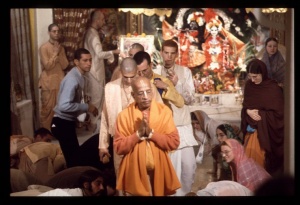CC Antya 13.61

A.C. Bhaktivedanta Swami Prabhupada
TEXT 61
- rakta-vastra 'vaiṣṇavera' parite nā yuyāya
- kona pravāsīre dimu, ki kāya uhāya?
SYNONYMS
rakta-vastra — saffron cloth; vaiṣṇavera — for a Vaiṣṇava; parite nā yuyāya — is not fit to put on; kona pravāsīre — to some outsider; dimu — I shall give; ki — what; kāya — business; uhāya — with that.
TRANSLATION
"This saffron cloth is unfit for a Vaiṣṇava to wear; therefore I have no use for it. I shall give it to a stranger."
PURPORT
Śrīla Bhaktisiddhānta Sarasvatī Ṭhākura comments on this incident as follows: Vaiṣṇavas are all liberated persons, unattached to anything material. Therefore a Vaiṣṇava need not accept the dress of a sannyāsī to prove his exalted position. Śrī Caitanya Mahāprabhu accepted the renounced order from a sannyāsī of the Māyāvāda school. Present-day Vaiṣṇava sannyāsīs, however, never think that by accepting the dress of the sannyāsa order they have become equal to Caitanya Mahāprabhu. In fact, a Vaiṣṇava accepts the sannyāsa order to remain an eternal servant of his spiritual master. He accepts the sannyāsa order knowing that he is unequal to his spiritual master, who is a paramahaṁsa, and he thinks that he is unfit to dress like a paramahaṁsa. Therefore a Vaiṣṇava accepts sannyāsa out of humility, not out of pride.
Sanātana Gosvāmī had adopted the dress of a paramahaṁsa; therefore it was inappropriate for him to wear the saffron cloth on his head. However, a Vaiṣṇava sannyāsī does not think himself fit to imitate the dress of a paramahaṁsa Vaiṣṇava. According to the principles set down by Śrī Caitanya Mahāprabhu (tṛṇād api su-nīcena), one should always think himself in the lowest stage, not on the level of a paramahaṁsa Vaiṣṇava. Thus a Vaiṣṇava will sometimes accept the sannyāsa order just to keep himself below the level of a paramahaṁsa Vaiṣṇava. This is the instruction of Śrīla Bhaktisiddhānta Sarasvatī Ṭhākura.